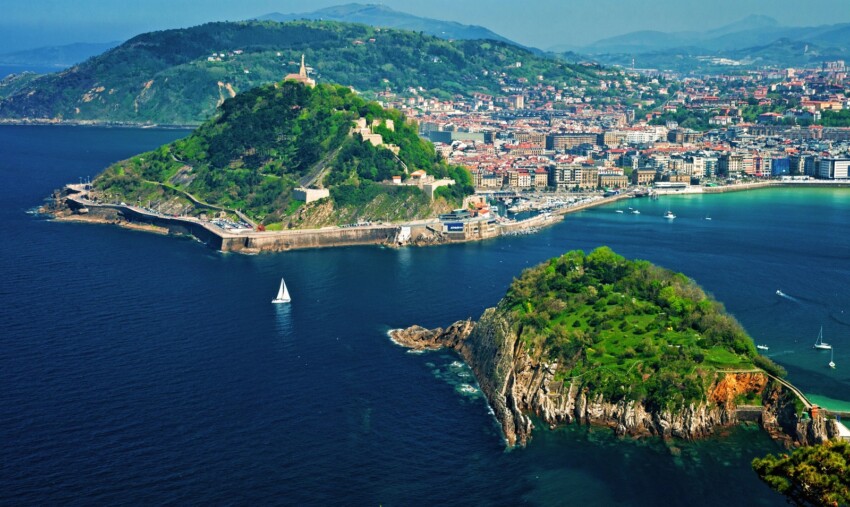

No wonder so many people are in love with San Sebastian (Donostia in Basque). It is a unique city, boasting an enviable location on a bay overlooking the Cantabrian Sea, surrounded by green mountains, and combining areas with distinct personalities and very different atmospheres in a very original way.
Its enchanting beaches, first and foremost La Concha, have become legendary: among the most beautiful city beaches in the world, they are perfect for hours of relaxation lying in the sun, refreshing baths and long walks and make for an exceptional photographic subject.
San Sebastian’s prestigious cultural events, interesting museums and original open-air sculptures, often in scenic locations by the sea, earned it the title of European Capital of Culture in 2016, and the cultural buzz has since been more alive than ever.
Modernity and innovation also invest in the world of cuisine, here a true work of art to which you must dedicate some time during your holiday! Go to traditional bars in search of the most appetising pintxos, perhaps washed down with a glass of fine cider or Tzakoli wine, and then experiment with more creative cuisine in chic restaurants.
In the evening, you can choose whether to indulge in the city’s vibrant nightlife or opt for a romantic moonlit stroll along the waterfront. No matter which you choose, it is certain that San Sebastian will steal your heart.
San Sebastian is a city that captivates visitors with its unique mix of culture, gastronomy and natural beauty. From its picturesque historical centre to its golden beaches, every corner tells a different story of this fascinating Basque town.
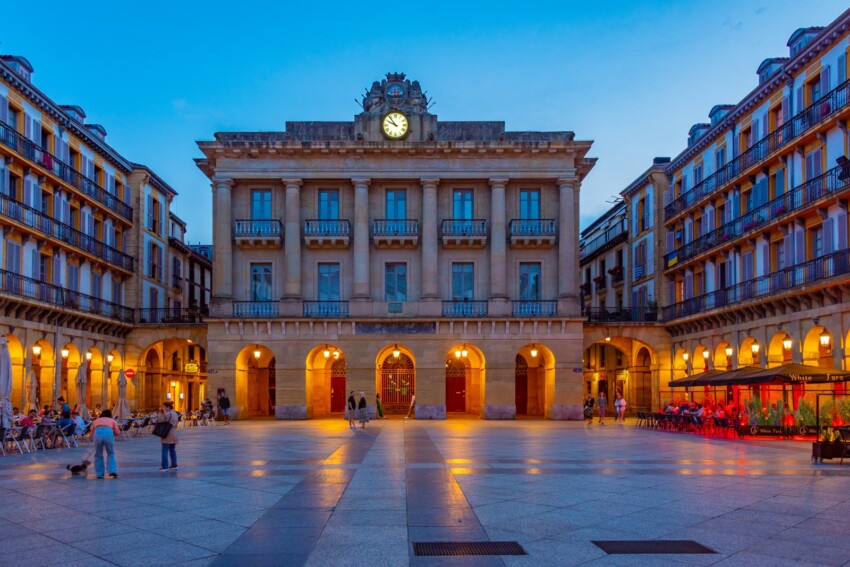
The historical centre of San Sebastian, locally known as Parte Vieja, is a maze of cobbled streets that hide some of the best pintxos bars in the city. This historical quarter, enclosed between Mount Urgull and the Urumea River, is the beating heart of the city’s social and gastronomic life.
The Plaza de la Constitución, with its numbered buildings that once housed the reserved seats during bullfights, is the focal point of the district. The surrounding narrow streets, in particular the famous Calle 31 de Agosto and Calle Mayor, are home to an incredible concentration of bars and restaurants where you can enjoy the famous Basque pintxos. In the evenings, the district transforms into a lively meeting point where locals and tourists mingle in the traditional custom of the ‘txikiteo’ (bar crawl for pintxos).
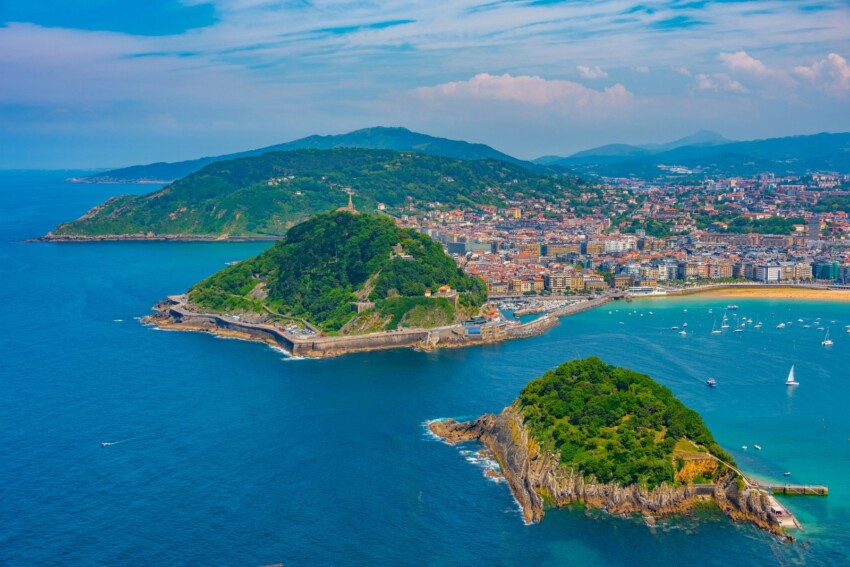
Mount Urgull, rising majestically behind the Parte Vieja, offers some of the most spectacular views of the city. This fortified hill, once crucial to the city’s defence, is now a public park criss-crossed by scenic paths leading to the statue of the Sagrado Corazón (Sacred Heart) at the summit.
The ancient walls and fortifications, including the 12th-century Castillo de la Mota, tell the city’s military history. The castle also houses the Casa de la Historia, a museum tracing the history of San Sebastian. The walk to the top takes about 30 minutes and offers increasingly spectacular views of La Concha Bay, the sea and the city.
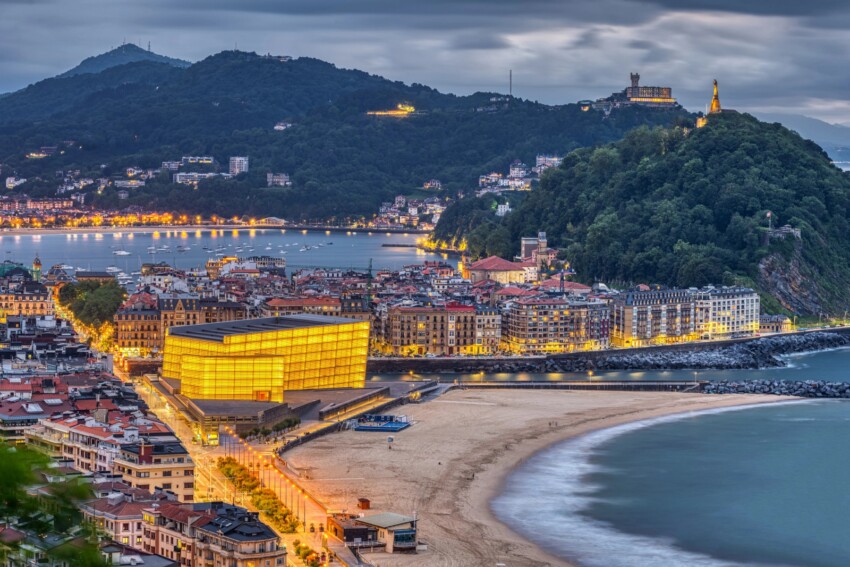
The Kursaal is the symbol of modern San Sebastian. This bold architectural complex, designed by Rafael Moneo, consists of two translucent glass cubes that look like two rocks stranded on Zurriola beach. The building, inaugurated in 1999, houses the city’s main convention centre and the headquarters of the San Sebastian International Film Festival.
At night, the cubes are illuminated, creating a spectacular effect that is reflected in the sea. The Kursaal is also a venue for important cultural events and houses one of the city’s most prestigious concert halls. The square in front has become a focal point for the city’s cultural life.
The Bretxa Market is the gastronomic heart of San Sebastian. This historical market, named after the breach in the city walls through which British troops entered in 1813, is the ideal place to discover local products and Basque gastronomic culture.
Downstairs, fish stalls display the best of the daily catch, while upstairs you will find local producers of cheese, cold meats, vegetables and other typical products. The market is also surrounded by cafés and bars where you can enjoy dishes prepared with fresh ingredients from the market.
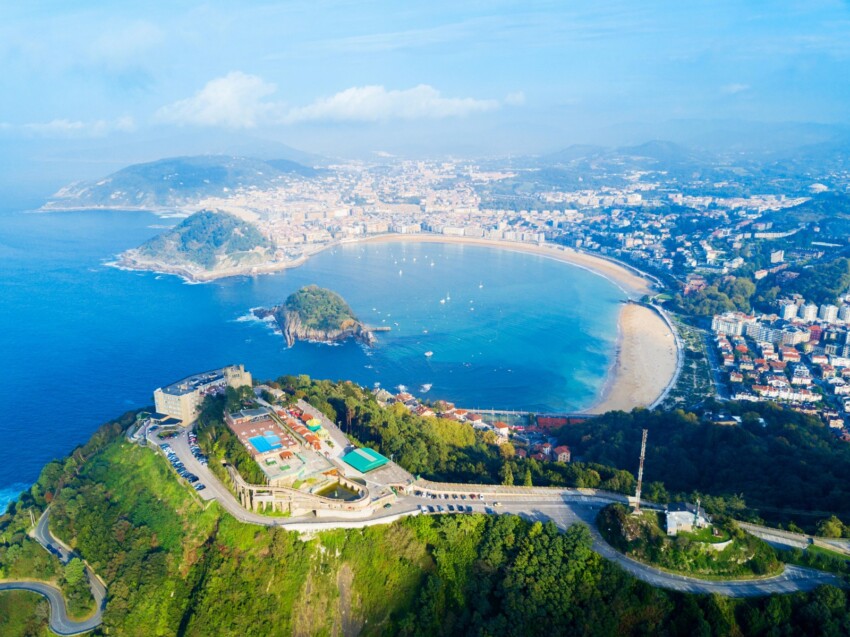
Monte Igueldo, which dominates the western end of the bay, offers what many consider the most spectacular view of San Sebastian. At the top is a retro amusement park from 1912, which retains much of its original charm, including the historic funicular railway that climbs from the base of the hill.
The main attraction is the viewpoint, from which one can admire the entire bay of La Concha, the city and the surrounding mountains. The historic lighthouse and viewing tower add a romantic touch to the atmosphere. The amusement park, with its vintage rides, is particularly popular with families.
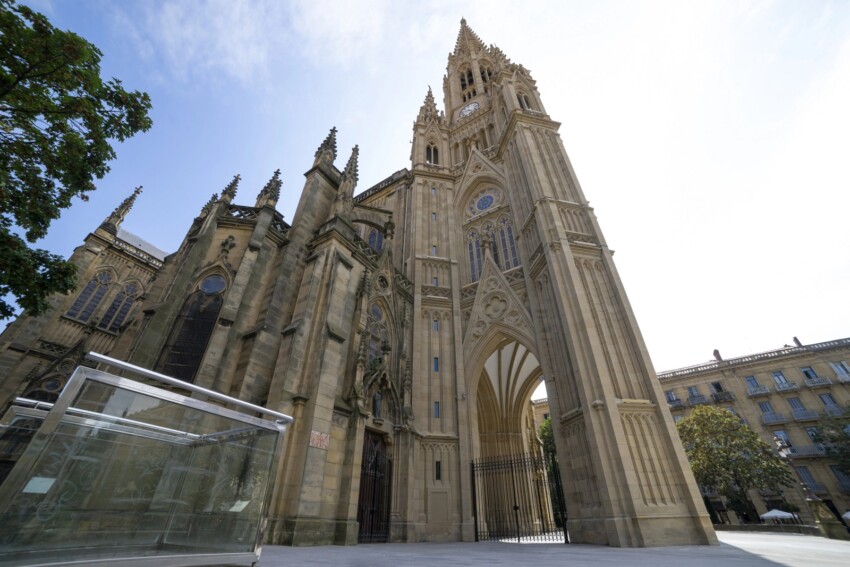
The Cathedral of the Good Shepherd is the main religious building in San Sebastian and an excellent example of neoclassical architecture. Built in the late 19th century in the Gothic Revival style, the cathedral is notable for its imposing 75-metre-high spire that dominates the city skyline.
The interior of the cathedral is striking for its brightness, thanks to the large stained glass windows that filter natural light, creating striking plays of colour. The local sandstone façade and elaborate architectural details testify to the historical importance of the building for the city.
Along the six kilometres of coastline bordering the bay and the surrounding areas are the three city beaches of San Sebastian, considered to be three of the most beautiful beaches in northern Spain. They are very famous and therefore, especially in the summer, quite crowded, but even if you are not alone, the beauty of the places is such that you cannot fail to be charmed by them.
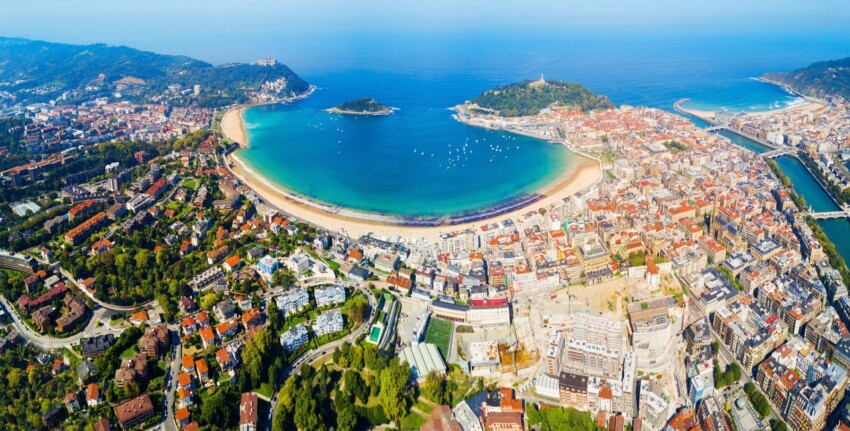
Of the three beaches in San Sebastian, La Concha is certainly the most famous, the most visited and the most photographed, and has become the city’s iconic image.
The name recalls in an all too obvious way the shell shape of the bay, with a 1.5 km long golden sandy shore washed by a beautiful blue sea. It is located right in the centre of town, extending from the Town Hall to the Pico del Loro, so it will be convenient for you to reach wherever your hotel is.
An elegant promenade, the Paseo de La Concha, runs parallel to the beach. It is a pedestrian promenade dotted with such famous features as the white railings built in 1910, the lampposts, the magnificent clock-columns that mark the entrances to the beach and the statue in homage to Fleming, the inventor of penicillin.
You can continue the walk by taking the Paseo Nuevo at the foot of Mount Urgull to the beach of La Zurriola: it is a relaxing 6 km urban route within everyone’s reach.
Along this route you can admire the Construcción Vacía (Empty Construction) statue by artist Jorge Oteiza, considered a landmark in contemporary art.
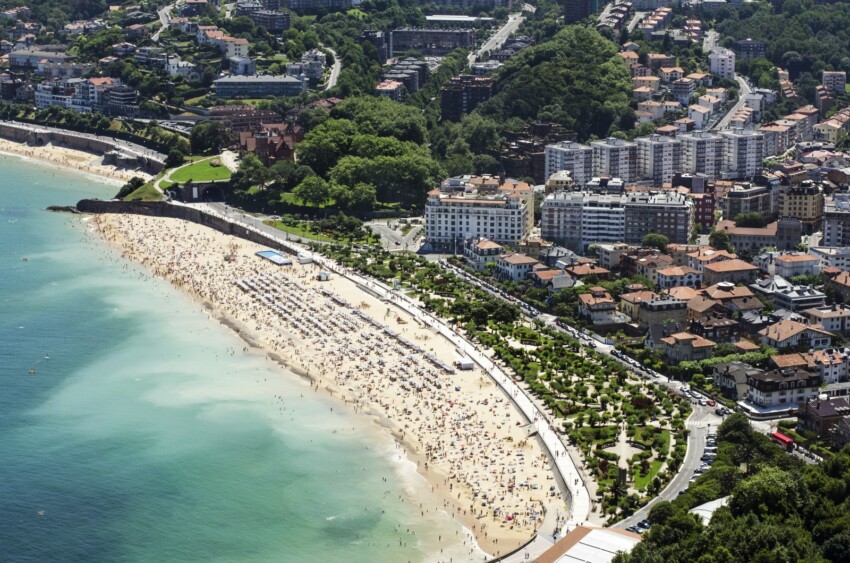
Ondarreta is another beautiful golden sandy beach, shorter than La Concha but much wider. It is located in the old quarter of the city, at the foot of Mount Igueldo. It is an equipped beach frequented mostly by locals and many families.
The attraction of the beach is the highly original sculpture Peine de los Vientos (Comb of the Winds), consisting of three giant metal sculptures of about 10 tonnes each embedded in the rock. It is the most famous work by artist Eduardo Chillida and has become, like La Concha, an iconic image of San Sebastian.
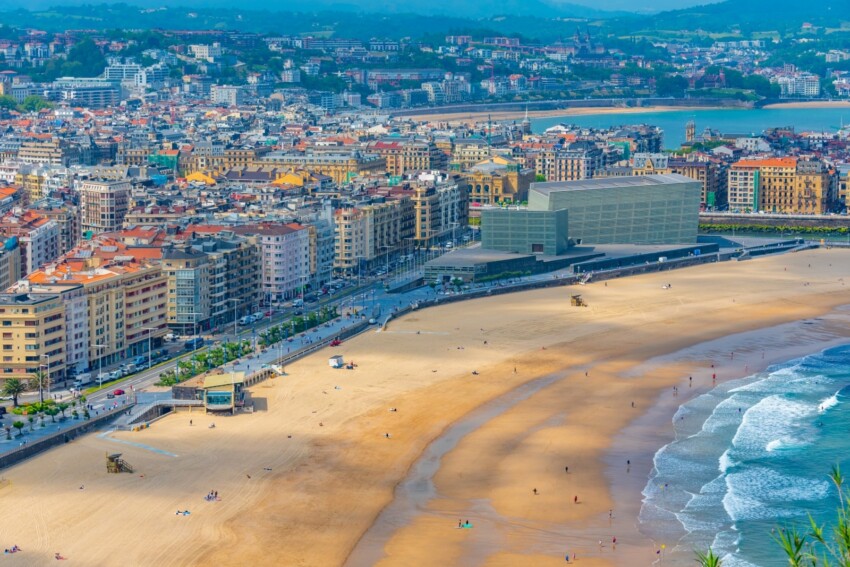
Of the three beaches in San Sebastian, La Zurriola is the beach for young people, a hangout for surfers, skateboarders and twenty-somethings looking for a good time. The area is full of clubs, bars and restaurants.
Here, too, you can admire an important work of contemporary art, the sculpture Bakearen Usoa (Dove of Peace) by Nestor Basterretxea, created in the 1980s to send a message of peace.
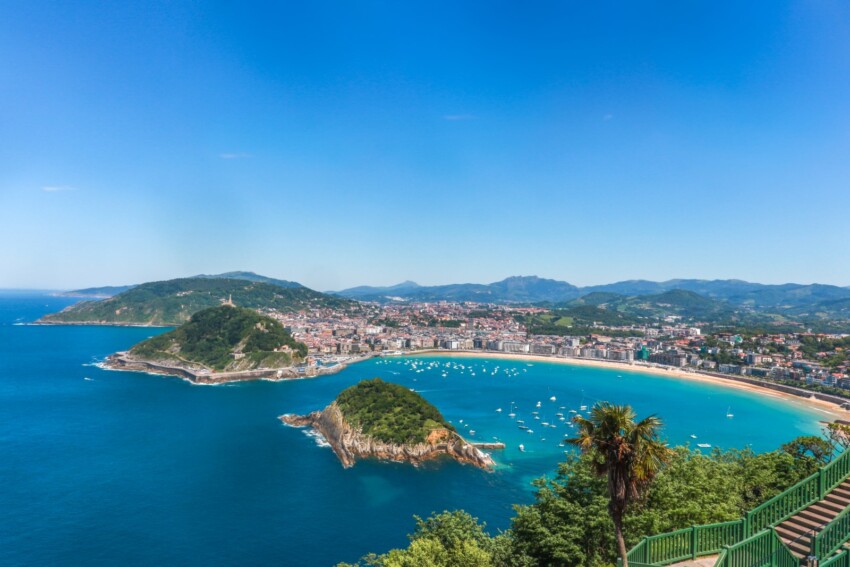
Directly opposite La Concha is Isla de Santa Clara, an uninhabited islet with a curious fish-like shape that becomes a popular Sunday excursion destination in summer.
It is so close to the beach that some venture to swim to it, but it is much more convenient to arrive by boat. On the island you can find a beach, a natural pool formed by sea water and a bar.
In the following map you can see the location of the main places of interest mentioned in this article.
San Sebastian is a culturally vibrant city with an interesting calendar of events, including some of national and international relevance. San Sebastian’s most popular events include the International Film Festival (one of Spain’s most important film festivals), the Fantastic and Horror Film Week, the Jazzaldia festival and the Quincena Musicale (classical music festival).
In August there is the Semana Grande, a lively popular festival with a full programme of events, including a prestigious International Fireworks Competition, regattas, music and theatre shows, a Taurine fair and traditional games.
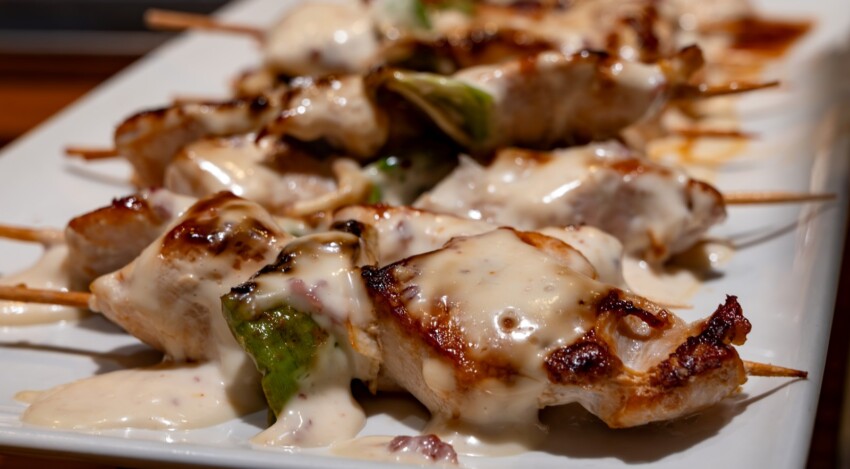
San Sebastian has a very rich food and wine tradition and is one of the favourite cities of food lovers around the world, so much so that many people now choose it as their destination for a gourmet holiday! If you too would like to organise a themed holiday, here is what you should definitely include in your programme.
Pintxos are the treasure trove of Basque gastronomy and you will be hard pressed to find anywhere else the levels of variety and quality that are achieved in San Sebastian.
Often compared to tapas, they were originally a simple slice of baguette bread stuffed with meat, fish or vegetables held in place with a toothpick. The tradition has evolved in such an imaginative way that you could spend an entire weekend eating only pintxos without getting bored! They are served almost everywhere, from noisy neighbourhood bars to trendy clubs.
Another great Basque tradition is the production of cider. To learn more about this still uncommon drink, which offers interesting possibilities for culinary pairings, visit the cider cellars in the area of San Sebastian and Astigarraga, places full of history and charm.
Treat yourself to at least one dinner in one of the Michelin restaurants in San Sebastian, a city that boasts an enviable number of starred restaurants, and browse the city’s gourmet markets.
If you are a real culinary aficionado, you can take a Basque cooking class and take home with you recipes for typical dishes to remember the best moments of your holiday! The prestigious Basque Culinary Centre organises courses in Spanish and English.
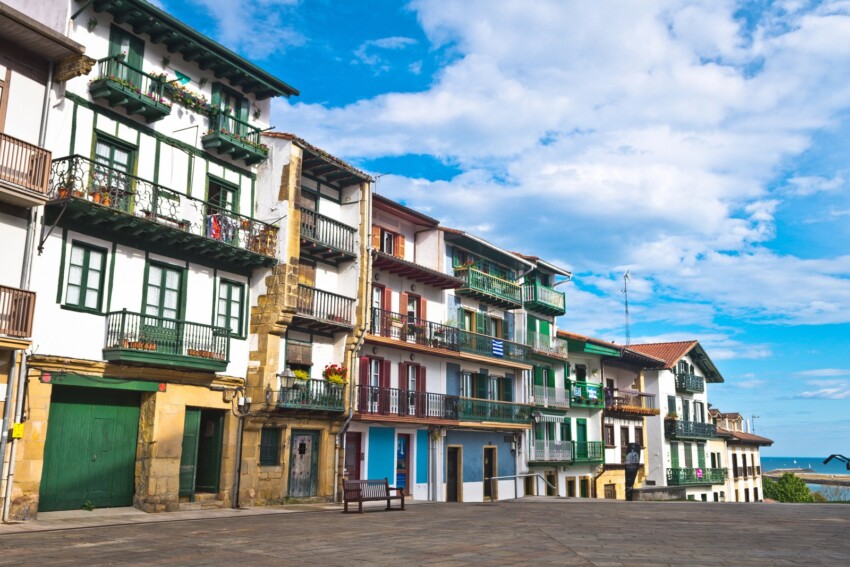
The surroundings of San Sebastian offer numerous opportunities for fascinating excursions, from the Basque coast to the picturesque villages inland.
This fortified medieval town is located just 20 km from San Sebastian. Its perfectly preserved historical centre, with colourful half-timbered houses and flower-decked balconies, is a true jewel of Basque architecture. The fishermen’s quarter, with its fish restaurants, is famous for its gastronomy. The 16th century fortress offers spectacular views of the mouth of the Bidasoa River and the French coast.
This picturesque fishing village, located 25 km from San Sebastian, is famous for its quaint harbour and for being the birthplace of fashion designer Cristóbal Balenciaga. The Balenciaga Museum is a must-see for fashion enthusiasts. The village is also renowned for its grilled fish restaurants and txakoli, the local white wine.
Just 5 km from San Sebastian, Pasaia is bisected by its spectacular natural harbour. The village retains an authentic maritime atmosphere and offers excellent fish restaurants. Don’t miss Victor Hugo’s house-museum, where the French writer stayed in 1843.
Less than an hour’s drive away are the elegant seaside resorts of the French Basque Country such as Biarritz, Saint-Jean-de-Luz and Bayonne. These cities offer an interesting fusion of Basque and French culture, as well as beautiful beaches and excellent gastronomy. Before reaching them, make a stop in Irun, the last town on Spanish soil.
San Sebastian is divided into four zones, each with its own personality and therefore suitable for a particular type of holiday.
The centre is the most characteristic and romantic area, perfect for a couple’s holiday or to get to know the more traditional San Sebastian; there are also excellent shopping opportunities. Due to the high concentration of family-run guesthouses and B&Bs, it is the recommended area for those seeking budget accommodation.
Gros is the ideal area for young people, with beaches perfect for surfing, sports shops, modern art galleries and live music venues.
The area between Mount Igueldo and Ondarreta beach is best suited for families, while Amara-Anoeta, the city’s newest district, is suitable for business travellers looking for 4-star hotels with all amenities.
San Sebastian has an international airport, but it is not connected with direct flights from Europe.
However, there are several options for getting to San Sebastian by plane, although they all involve an additional journey by bus or hire car:
The first scenario, if your reference airport offers direct flights to Bilbao, is probably the most convenient solution.
If you are already in Spain, it will be easy for you to get to San Sebastian with a rental car because the city is located at a crossroads of roads that quickly connect it to all major locations in northern and central Spain.
If you prefer to travel by public transport, there are direct buses and trains from Madrid, Barcelona and other national and international locations.
What's the weather at San Sebastian? Below are the temperatures and the weather forecast at San Sebastian for the next few days.
San Sebastián overlooks the Atlantic Ocean and is located in the eastern part of the Basque Country, in the north-eastern part of Spain. It is closer to the French border than Bilbao, from which it is exactly 100 kilometres away.